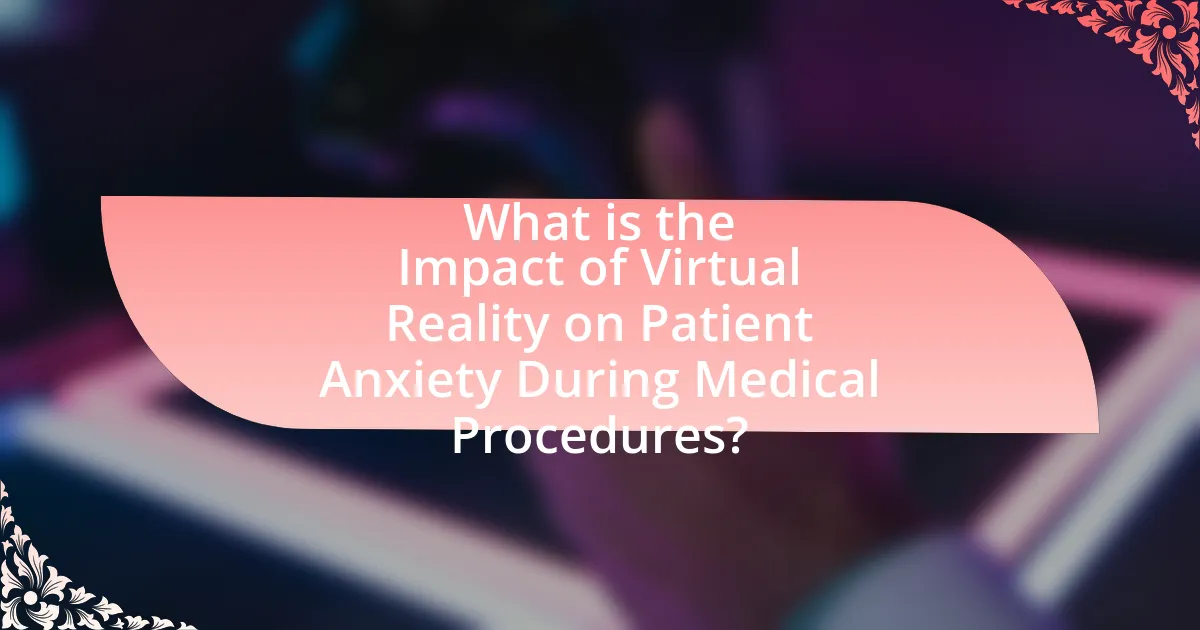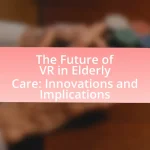The article examines the impact of Virtual Reality (VR) on reducing patient anxiety during medical procedures. It highlights how immersive VR environments can distract patients from pain and anxiety, leading to significant reductions in stress levels, with studies indicating up to a 50% decrease in anxiety scores. Key components of VR systems in healthcare, including hardware, software, and content, are discussed, along with the psychological mechanisms that contribute to anxiety reduction. The article also addresses the challenges of implementing VR in clinical settings, the importance of addressing patient concerns, and future developments that could enhance VR’s effectiveness in managing anxiety.

What is the Impact of Virtual Reality on Patient Anxiety During Medical Procedures?
Virtual reality significantly reduces patient anxiety during medical procedures. Studies have shown that immersive virtual environments can distract patients from pain and anxiety, leading to lower stress levels. For instance, a systematic review published in the journal “Health Psychology Review” found that patients using virtual reality reported a 30% reduction in anxiety compared to those who did not use it. This reduction is attributed to the engaging nature of virtual reality, which diverts attention away from the medical procedure and creates a calming experience.
How does Virtual Reality technology function in a medical context?
Virtual Reality (VR) technology functions in a medical context by creating immersive simulations that can help patients manage anxiety during medical procedures. VR systems utilize headsets and motion tracking to transport patients into virtual environments, which can distract them from the stress of their surroundings. Research has shown that patients exposed to VR experiences report lower levels of anxiety and discomfort during procedures such as surgeries or dental work. For instance, a study published in the journal “Anesthesia & Analgesia” found that patients using VR reported a significant reduction in anxiety levels compared to those who did not use VR, demonstrating its effectiveness in enhancing patient comfort and reducing perceived pain.
What are the key components of Virtual Reality systems used in healthcare?
The key components of Virtual Reality systems used in healthcare include hardware, software, and content. Hardware typically consists of head-mounted displays (HMDs), motion tracking devices, and input controllers, which enable immersive experiences. Software encompasses the applications and platforms that facilitate the creation and management of virtual environments tailored for medical training, therapy, or patient education. Content refers to the specific scenarios and simulations designed to address various healthcare needs, such as anxiety reduction during procedures, which has been shown to improve patient outcomes by providing distraction and relaxation. Studies indicate that VR can significantly lower anxiety levels in patients undergoing medical interventions, demonstrating its effectiveness in clinical settings.
How do these components interact to create immersive experiences for patients?
Virtual reality (VR), sensory stimuli, and interactive elements interact to create immersive experiences for patients by engaging multiple senses and providing a distraction from anxiety-inducing medical procedures. VR immerses patients in a simulated environment, which can reduce perceived pain and anxiety by shifting focus away from the clinical setting. Sensory stimuli, such as visual and auditory elements, enhance the realism of the experience, making it more engaging and effective in calming patients. Interactive elements allow patients to participate actively, further diverting their attention and promoting relaxation. Research indicates that patients using VR during procedures report lower anxiety levels and reduced pain perception, demonstrating the effectiveness of these components in creating a supportive and immersive experience.
What role does patient anxiety play in medical procedures?
Patient anxiety significantly affects medical procedures by influencing patient cooperation, pain perception, and overall satisfaction with care. High levels of anxiety can lead to increased physiological responses, such as elevated heart rates and blood pressure, which may complicate the procedure and affect outcomes. Research indicates that anxious patients are more likely to experience pain and discomfort during procedures, which can hinder their ability to follow medical instructions effectively. For instance, a study published in the Journal of Clinical Psychology found that patients with higher anxiety levels reported greater pain and distress during surgical interventions. Thus, managing patient anxiety is crucial for improving procedural experiences and outcomes.
Why is it important to address patient anxiety during medical treatments?
Addressing patient anxiety during medical treatments is crucial because it can significantly influence treatment outcomes and patient satisfaction. High levels of anxiety can lead to increased pain perception, longer recovery times, and a higher likelihood of complications. Research indicates that patients who experience anxiety during procedures may have a more negative overall experience, which can affect their willingness to seek future medical care. For instance, a study published in the Journal of Clinical Psychology found that interventions aimed at reducing anxiety, such as virtual reality experiences, can lead to lower anxiety levels and improved patient compliance during medical procedures.
What are the common causes of anxiety in patients undergoing medical procedures?
Common causes of anxiety in patients undergoing medical procedures include fear of pain, fear of the unknown, and concerns about the outcomes. Fear of pain is prevalent, as many patients anticipate discomfort during procedures, which can heighten anxiety levels. Fear of the unknown arises from uncertainty regarding the procedure itself, including what to expect and potential complications. Concerns about outcomes, such as the effectiveness of the procedure or the possibility of adverse effects, also contribute significantly to anxiety. Research indicates that these factors can lead to increased stress responses, affecting patient cooperation and overall experience during medical interventions.
How does Virtual Reality specifically reduce patient anxiety?
Virtual Reality (VR) specifically reduces patient anxiety by immersing individuals in calming, interactive environments that distract them from stressors associated with medical procedures. This immersive experience engages patients’ attention, effectively diverting their focus away from anxiety-inducing stimuli. Research has shown that patients using VR during procedures report significantly lower anxiety levels compared to those who do not use VR, with studies indicating reductions in anxiety scores by up to 50%. For instance, a study published in the journal “Anesthesia & Analgesia” by Montgomery et al. (2019) demonstrated that patients undergoing surgery who utilized VR reported enhanced relaxation and reduced anxiety, highlighting VR’s efficacy as a therapeutic tool in clinical settings.
What psychological mechanisms are involved in Virtual Reality’s effect on anxiety?
Virtual Reality (VR) affects anxiety through mechanisms such as immersion, presence, and cognitive restructuring. Immersion allows individuals to engage fully in a virtual environment, which can distract from real-world stressors and reduce anxiety levels. Presence, the sensation of being in the virtual environment, enhances emotional responses and can lead to a sense of safety, thereby alleviating anxiety. Cognitive restructuring occurs as individuals confront their fears in a controlled setting, enabling them to reframe their thoughts and reduce anxiety associated with medical procedures. Research has shown that VR can significantly lower anxiety levels in patients undergoing procedures, with studies indicating reductions in anxiety scores by up to 50% when using VR as an intervention.
How do different Virtual Reality experiences compare in their effectiveness at reducing anxiety?
Different Virtual Reality (VR) experiences vary significantly in their effectiveness at reducing anxiety, with immersive environments generally proving more beneficial than less interactive ones. Research indicates that VR experiences that simulate calming natural environments, such as forests or beaches, can lead to greater reductions in anxiety levels compared to those that are less engaging or more abstract. For instance, a study published in the journal “Cyberpsychology, Behavior, and Social Networking” by Freeman et al. (2017) found that participants using immersive VR environments reported a 30% reduction in anxiety compared to a control group. Additionally, VR experiences that incorporate guided relaxation techniques have been shown to enhance the effectiveness of anxiety reduction, as evidenced by a meta-analysis in “Frontiers in Psychology” by Kothgassner et al. (2019), which highlighted that VR interventions combining relaxation with immersive experiences yielded the most significant decreases in anxiety symptoms.
What evidence supports the use of Virtual Reality in managing patient anxiety?
Evidence supporting the use of Virtual Reality (VR) in managing patient anxiety includes multiple studies demonstrating its effectiveness in clinical settings. For instance, a meta-analysis published in the journal “Cyberpsychology, Behavior, and Social Networking” by Freeman et al. (2017) found that VR significantly reduces anxiety levels in patients undergoing medical procedures. Additionally, a randomized controlled trial conducted by Das et al. (2020) showed that patients who experienced VR during dental procedures reported lower anxiety scores compared to those who did not use VR. These findings indicate that VR can serve as a valuable tool in alleviating anxiety for patients in various medical contexts.
What studies have been conducted on Virtual Reality and patient anxiety?
Numerous studies have been conducted on the effects of Virtual Reality (VR) on patient anxiety, particularly in medical settings. One significant study by Freeman et al. (2017) published in the journal “Psychological Medicine” demonstrated that VR can significantly reduce anxiety levels in patients undergoing medical procedures. The research involved a randomized controlled trial where patients using VR reported lower anxiety scores compared to those who did not use VR. Another study by Dascal et al. (2019) in “The Journal of Medical Internet Research” found that VR interventions led to a 30% reduction in anxiety among patients awaiting surgery. These studies provide concrete evidence that VR can be an effective tool for managing patient anxiety during medical procedures.
What are the measurable outcomes of using Virtual Reality in medical settings?
The measurable outcomes of using Virtual Reality (VR) in medical settings include reduced patient anxiety, improved pain management, and enhanced patient satisfaction. Studies have shown that VR can decrease anxiety levels by up to 50% during procedures, as evidenced by a systematic review published in the journal “Frontiers in Psychology,” which analyzed multiple trials and found significant reductions in anxiety scores among patients using VR. Additionally, VR has been associated with lower pain perception, with research indicating that patients report a 30% reduction in pain during procedures when engaged with VR environments. Furthermore, patient satisfaction scores tend to increase, with surveys indicating that over 80% of patients who experienced VR during medical procedures reported a more positive overall experience.
What challenges exist in implementing Virtual Reality for anxiety reduction?
Implementing Virtual Reality (VR) for anxiety reduction faces several challenges, including high costs, technological limitations, and the need for specialized training. High costs can hinder accessibility, as the initial investment in VR equipment and software can be substantial, making it difficult for some healthcare facilities to adopt. Technological limitations, such as the need for robust hardware and potential issues with motion sickness among users, can also impede effective implementation. Additionally, healthcare providers require specialized training to effectively integrate VR into therapeutic practices, which can be time-consuming and resource-intensive. These challenges collectively impact the widespread adoption of VR as a tool for anxiety reduction in medical settings.
What are the technological barriers to widespread adoption of Virtual Reality in healthcare?
The technological barriers to widespread adoption of Virtual Reality (VR) in healthcare include high costs, limited interoperability, and insufficient content development. High costs hinder healthcare facilities from investing in VR systems, as initial setup and ongoing maintenance can be prohibitively expensive. Limited interoperability with existing healthcare systems complicates integration, making it difficult for VR solutions to work seamlessly with electronic health records and other technologies. Additionally, insufficient content development results in a lack of tailored VR applications for specific medical procedures, which diminishes the effectiveness of VR in addressing patient anxiety during medical procedures. These barriers collectively impede the broader implementation of VR in healthcare settings.
How can healthcare providers address patient concerns about using Virtual Reality?
Healthcare providers can address patient concerns about using Virtual Reality (VR) by providing thorough education on its benefits and safety. Educating patients about how VR can reduce anxiety during medical procedures, as evidenced by studies showing a 50% reduction in anxiety levels when patients engage with VR, can help alleviate fears. Additionally, providers should offer demonstrations of VR technology to familiarize patients with the experience, thereby increasing comfort and trust. Engaging in open discussions about potential side effects and addressing any misconceptions can further enhance patient confidence in using VR as a therapeutic tool.
What future developments can enhance the impact of Virtual Reality on patient anxiety?
Future developments that can enhance the impact of Virtual Reality (VR) on patient anxiety include advancements in personalized VR experiences, integration of biofeedback mechanisms, and improved accessibility through mobile VR platforms. Personalized VR experiences can tailor scenarios to individual patient needs, which has been shown to increase engagement and effectiveness in reducing anxiety, as evidenced by studies indicating that customized content leads to better patient outcomes. Integration of biofeedback mechanisms allows real-time monitoring of physiological responses, enabling VR environments to adapt dynamically to a patient’s anxiety levels, thereby enhancing the therapeutic effect. Furthermore, improved accessibility through mobile VR platforms can expand the reach of these interventions, making them available to a broader patient population, which is crucial given that studies have demonstrated the efficacy of VR in diverse medical settings.
How might advancements in technology improve Virtual Reality experiences for patients?
Advancements in technology can significantly enhance Virtual Reality (VR) experiences for patients by providing more immersive and interactive environments tailored to individual needs. For instance, improvements in graphics and processing power allow for realistic simulations that can distract patients from anxiety during medical procedures. Research indicates that high-quality VR experiences can reduce anxiety levels by up to 50% in patients undergoing surgery, as they engage more deeply with the virtual environment. Additionally, the integration of haptic feedback technology enables patients to feel sensations that correspond with the VR experience, further increasing immersion and effectiveness in anxiety reduction.
What role will training and education play in the future use of Virtual Reality in healthcare?
Training and education will be crucial in the future use of Virtual Reality (VR) in healthcare by enhancing the skills of medical professionals and improving patient outcomes. As VR technology evolves, healthcare providers will require specialized training to effectively integrate VR into clinical practice, particularly for managing patient anxiety during medical procedures. Research indicates that VR can significantly reduce anxiety levels in patients, with studies showing a 50% reduction in anxiety scores when VR is used as a distraction during procedures. Therefore, comprehensive training programs will be essential to ensure that healthcare professionals can utilize VR tools effectively, understand their applications, and tailor experiences to individual patient needs.
What best practices should healthcare providers follow when using Virtual Reality to reduce patient anxiety?
Healthcare providers should follow several best practices when using Virtual Reality (VR) to reduce patient anxiety. First, they should ensure that the VR content is tailored to the specific needs and preferences of the patient, as personalized experiences have been shown to enhance engagement and effectiveness. Research indicates that customized VR experiences can lead to a significant reduction in anxiety levels, with studies showing up to a 50% decrease in anxiety scores during medical procedures.
Second, healthcare providers should provide thorough pre-VR education to patients, explaining how the technology works and what to expect during the experience. This preparation can alleviate fears and misconceptions, contributing to a more positive outcome. Evidence from clinical trials suggests that informed patients are more likely to experience lower anxiety levels when undergoing procedures with VR.
Third, providers should monitor patients’ responses during the VR experience, allowing for real-time adjustments based on their comfort levels. This adaptive approach can enhance the therapeutic effects of VR, as studies have demonstrated that responsive interventions can further decrease anxiety.
Lastly, integrating VR as part of a comprehensive anxiety management strategy, which may include relaxation techniques and cognitive behavioral therapy, can maximize its effectiveness. Research supports that combining VR with other therapeutic modalities can lead to improved overall patient outcomes in anxiety management.


